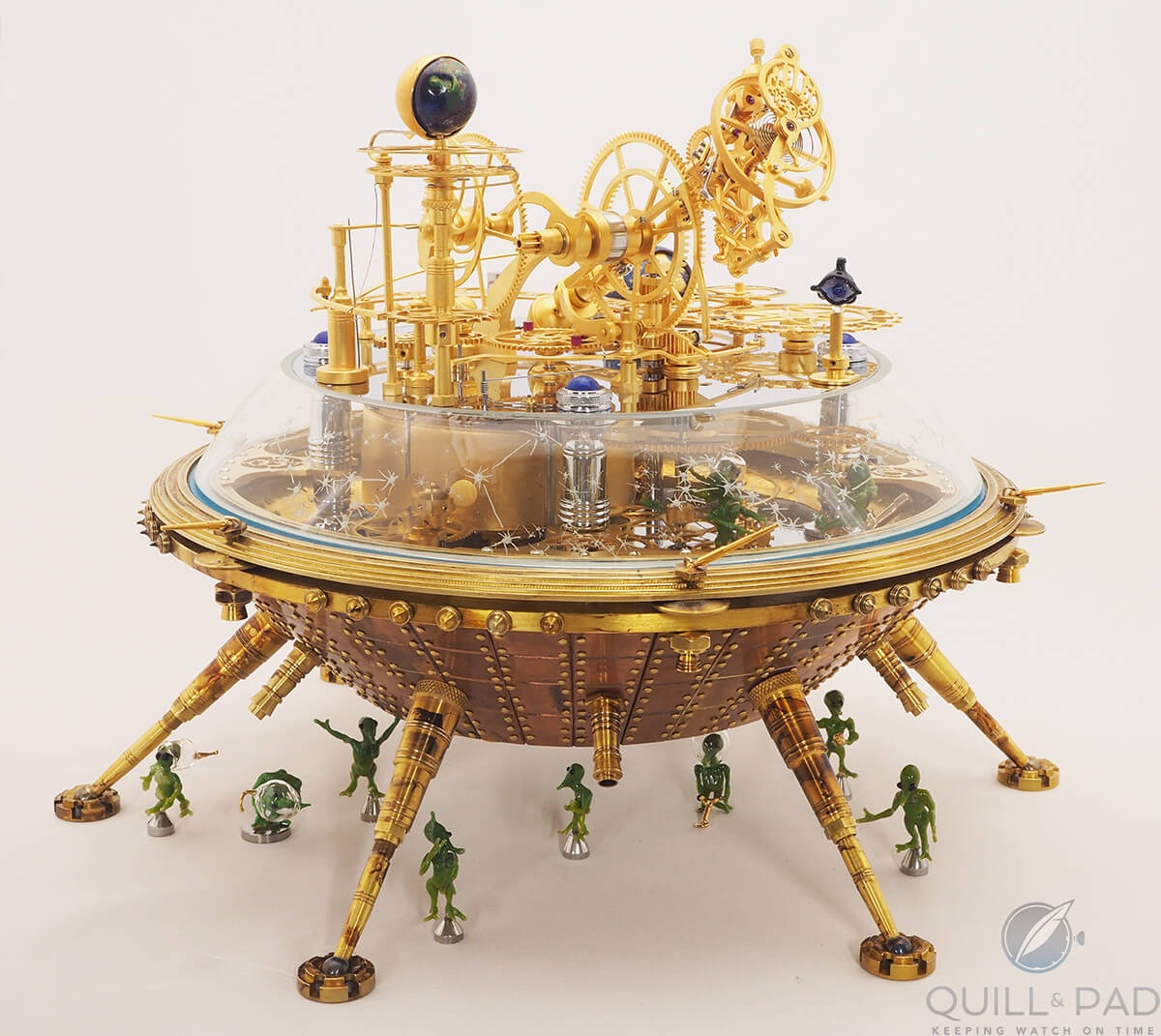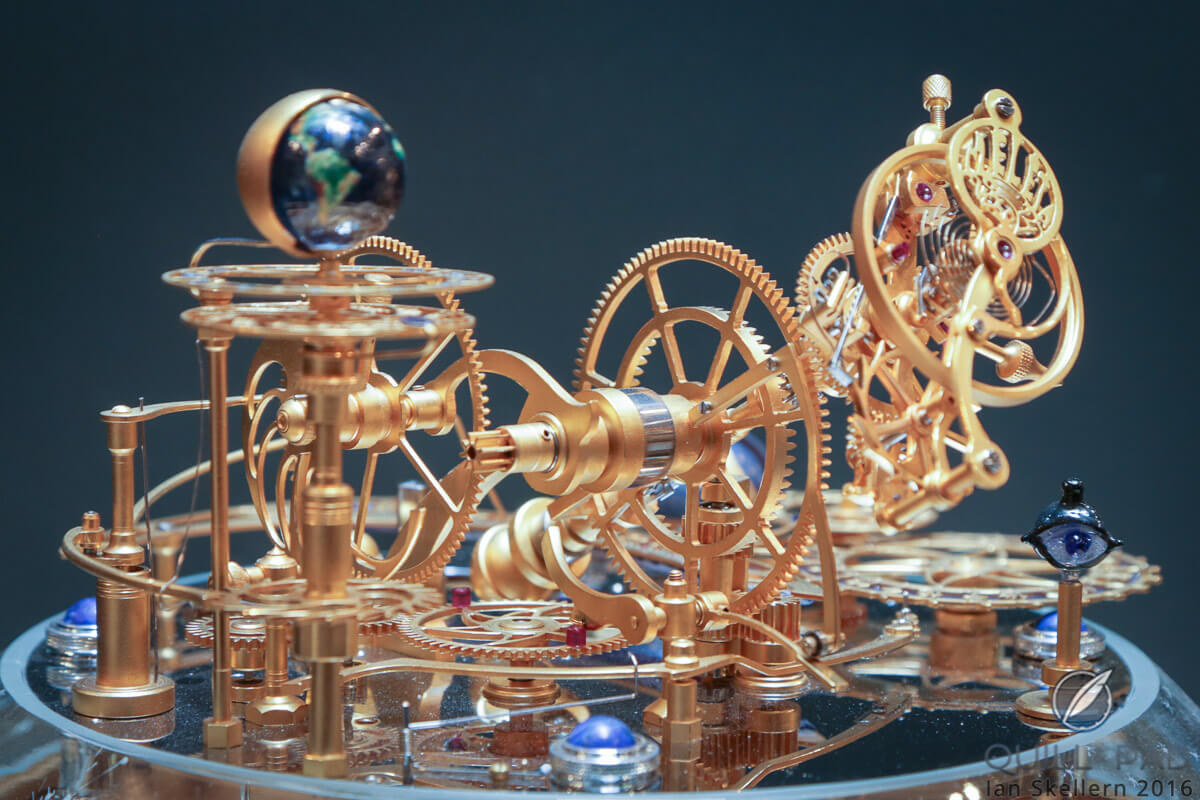What you are about to read is a work of fantasy directly inspired by the work and details of Miki Eleta’s BY 21Dez12ME clock.

BY 2112ME by Miki Eleta

One of Miki Eleta’s original working sketches for BY 21Dez12ME
The chief navigator paused and checked the coordinates against the holographic star chart surrounding the cabin, suddenly realizing that the starship called BY 21Dez12ME was, to put it delicately, astonishingly lost.
The holographic star chart, resembling a dome of glass, carried the relevant star data for the entire journey to Nova Epsilon 128-3B. Nowhere the navigator looked on the star chart even remotely resembled the galactic sector the ship now found itself in. Had this been his first rodeo (as the old Earth: Prime saying went), he probably would have been in a state resembling a frantic squirrel in the dead of winter looking for his last stash of nuts.
Luckily for navigator G. Stadelmann, it wasn’t.

Not only was he familiar with the realities (and potential problems) of faster-than-light (FTL) interstellar travel, he had painstakingly created the holographic star chart himself during his six-month residency at Zurich Galactic Cartography & Holo-Glass, Inc. This meant that Stadelmann could use the vast understanding gleaned from his preparation and research to methodically reorient their navigational instruments.
But first he was required to notify the captain as per the protocols set before departure so it could be determined what had gone wrong. Reaching down to activate his voice transmitter, Guido (which Stadelmann preferred the rest of the crew call him) opened a channel and started to speak.
“Attention, Captain Eleta, this is Stadelmann from navigation.”
“Go ahead, Guido,” the captain replied.
“We have arrived after our first FTL jump and are calculating our current position to determine a further course toward the destination. As was predicted in one of the pre-launch simulations, we appear to be slightly off from flight position B3.20.16,” Guido said without so much as a hint of concern.

“Exactly how far off are we? And does this change the required jumps to get to our destination?” inquired Captain Eleta, already understanding what the likely answer was.
“Well . . . ” started the navigator, “it appears that until further review and verification, we have no idea.”
The captain sighed, “Okay, I’ll be right over. Can you notify Ackey in engineering that it appears the gravity tourbillon drive may need adjusting and we will likely need to perform an EVA to check for damage to the exterior of the unit?”
“Will do, sir,” came the response as Guido immediately switched to another channel and asked the engineering administrator to put him in touch with the AHCI, which the captain always called “Ackey” instead of just intonating the letters of the organization like everyone else.

One of Miki Eleta’s original working sketches for BY 21Dez12ME
An elite organization made up of the engineer crewmen and crewwomen scoring extremely well on a military special ops exam taken while at the Galactic Academy had formed a specialist subgroup within the engineering department.
These cadets not only showed a seriously advanced ability to almost independently engineer and build machines, but also a strong inclination for highly dangerous and risky objectives.
The AHCI, which stands for Advanced Help & Control Initiative, was absolutely vital to the wellbeing of the ship as a machine, and even the entire industry of the Galactic Fleet. Possessing essential theoretical and practical knowledge and skills, these carefully vetted and hand-selected individuals basically drove the entire human race forward.

BY 2112ME by Miki Eleta
The ship’s commander Captain Eleta, who as the ship’s captain was in charge of the AHCI, was a very distinguished AHCI member in his own right.

One of Miki Eleta’s original working sketches for BY 21Dez12ME
The marvelous machine
Within fifteen minutes, the entire AHCI core team including the captain, the chief navigator, the chief officer, and the first pilot were all on the bridge ready to discuss the issue at hand: finding out where exactly they were.
Chief Navigator Stadelmann and Captain Eleta began by describing what likely went wrong during the first FTL jump.
The machine that controls the FTL travel divides the interstellar journey into twenty-four equal segments. Each segment takes one hour of faster-than-light travel to complete one jump. Huge spans of distance can be traversed in this timeframe.
The jump hour FTL mechanism causes a slight shift in the timeline experienced by those aboard the ship, so that what seems like just a single hour of traveling actually works out to be about the same amount of time that, for those on Earth: Prime, the moon takes to complete a full cycle:: approximately 29.5 days.
For this reason, the ship also contains a moon phase calculator that shows the corresponding relativistic time.

BY 2112ME by Miki Eleta

One of Miki Eleta’s original working sketches for BY 21Dez12ME
The cause behind ending up in the wrong galactic sector, Stadelmann and Eleta explained, was most likely due to the snail effect on the minute countdown during the jump hour. Over the course of the hour, an indicator is driven by the corresponding “snail effect,” a quantum byproduct of FTL interstellar travel.
The snail effect, when graphed, resembles a spiraling snail shell or a snail cam (to anybody interested in mechanics) that plots the growth in the probability of error.
As the jump hour duration increases, the snail effect error plot points move away from the center (where the probability of jump error is zero) until it reaches the maximum acceptable risk at 59 minutes and 59 seconds (which is approximately 0.5X/3∆V probability of error). At this point the jump hour concludes, the minute indication retrogrades to zero, and the system resets for the next FTL jump hour.

If the jump worked as calculated, the ship would be exactly in the intended interstellar location.
But if at some time along the duration of the jump a quantum anomaly occurred (a likelihood that increases as relativistic time passes), the final location will be affected by the inverse of Y2 + (V x 3)2. The easiest way to determine if this occurred, and by how much, is to cross reference the intended time relative to world time position (which is always displayed as x/24 on the time indication sphere) with the moon phase quotient.
The answer should always be 1/1 after the first jump, except in the case of a quantum anomaly.
Interstellar mechanics
After conferring with First Pilot V. Calabrese, Stadelmann and Captain Eleta calculated that the relative position of the ship was at 0.9981/1 of jump location Alpha based on relativistic time. This sounds pretty accurate, but when considering the massive interstellar distances, the BY 21Dez12ME could still be more than 1.34 trillion miles from where it was supposed to be in the best case scenario.
If you add the fact that the tourbillon drive uses the chronometer escapement wave function as the propulsion source, and the path of the starship isn’t linear but toroidal, it is theoretically possible that the ship could actually be further from the destination than when the FTL jump hour began.
Luckily this was not the case and after some careful comparisons it turned out that the reason the holographic star charts showed nothing familiar was because the quantum anomaly resulted in a transfer of the FTL path from one toroid plane to an adjacent one. The ship had ended its first jump hour in a different system but only changed planes once, which could be counteracted with a few complicated quantum equations.
The AHCI core still needed to perform a visual and electrical diagnostic on the external control panel and quantum balance of the tourbillon drive, which was located in the nose of the ship, directly above the navigation and control bridge where they had gathered.
An EVA was going to be required for this, which was always a risky maneuver, but it was exactly what the AHCI had signed up for in the Galactic Academy. The space walkers exited the ship through the aft-side hatch and traversed around the exterior of the ship. They made their way past the stabilizing struts and the mid-hull positioning thrusters until they reached the leading-edge attachment arms. These arms allowed for a secure connection and a positionable extension for greater maneuverability while performing repairs.

BY 2112ME by Miki Eleta
During the diagnostic it was discovered that the axis of the atomic escape wheel compensator had been nudged out of alignment, probably due to a few rogue bits of dark matter that interacted with the electromagnetic mounts. Realignment with an ultra-precise, low-yield fiber laser moved the axis back into its proper position while a full mechanical inspection was being performed on the rest of the drive.
All in a day’s work
In all, the work took less than a standard jump period and the ship was readied for its next jump hour rather quickly. Given that this delay had caused the BY 21Dez12ME to miss its next FTL jump, and the course correction would take a full jump hour to get back on track, the crew would be about a month late arriving to Nova Epsilon 128-3B.
Of course, to the crew it would only be a couple extra hours of on-ship time, the total relativistic travel time would now be a little over two years if no further delays were incurred.

Base of BY 2112ME by Miki Eleta
Being a regularly scheduled supply and science mission headed to a long-term settlement on NE 128-3B, this small change in arrival time would barely register to the explorers already there. According to the weekday indication, instead of arriving on a Tuesday they would arrive a month later on a Friday, meaning a nice couple days off before settling in for their residency on a planet not too dissimilar from Earth: Prime.
It was an exciting time to be working in interstellar terraforming, and everyone was anxious to get to work.

One of Miki Eleta’s original working sketches for BY 21Dez12ME
As Chief Navigator Stadelmann finished the calculations and uploaded the new coordinates for the second FTL interstellar jump, the captain sat down to verify the ship’s direction.
“Well, Guido, it looks like this trip started off with a little excitement. You did a fantastic job in handling the situation. If you keep it up, you just may be considered for chief officer on the return journey,” the captain suggested.
“You know I don’t want that job, Miki. I love it here with the holo-glass charts and the clear view of the galaxy. It’s my own personal universe up here,” Guido mused.
“I knew you would say that, but I had to offer,” replied the captain.

View from above: BY 2112ME by Miki Eleta
Miki Eleta, captain of the starship BY 21Dez12ME patted Chief Navigator Stadelmann on the shoulder as he got up to leave. He was glad his old friend had found his place in the universe, even if it was while plotting the course for others. He figured that was how it worked, though, since he found his calling while in the AHCI on a smaller starship named the USS Hippocampus.
It seemed that no matter where in the universe he went he was on a continuum of exploration. Such is the life of a starship captain.

One of Miki Eleta’s original working sketches for BY 21Dez12ME
For more information and less fantasy about the incredible BY 21Dez12ME by Miki Eleta, please visit www.mikieleta.com/timepieces/by-21dez12me.

BY 2112ME by Miki Eleta
And if you are wondering about the unusual name “BY 21Dez12ME” it derives from the following:
BY: B’olon Yokte K’uh, a Mayan god
21Dez12: the date predicted that the god would return to earth (or not)
ME: Miki Eleta
Quick Facts
Case: 25 x 20 cm in gold-plated brass, bronze, chrome steel, glass, lapis lazuli, ruby
Movement: custom manual winding Caliber BY 21Dez12ME with constant force and new gravity tourbillon
Functions: jumping hours, retrograde minutes;; weekday, moon phase, world time indication
Limitation: unique piece
Price: upon request
Trackbacks & Pingbacks
-
[…] we published Inspired Interstellar Exploration: Miki Eleta BY 21Dez12ME Starship Clock a couple of weeks ago, quite a few readers requested video to better appreciate how Miki Eleta’s […]
-
[…] we published Inspired Interstellar Exploration: Miki Eleta BY 21Dez12ME Starship Clock a couple of weeks ago, quite a few readers requested video to better appreciate how Miki […]
Leave a Reply
Want to join the discussion?Feel free to contribute!

No video? GAH!
I promise that we will publish a video as soon as I can get one Tim, I am as curious as you to see it in operation.